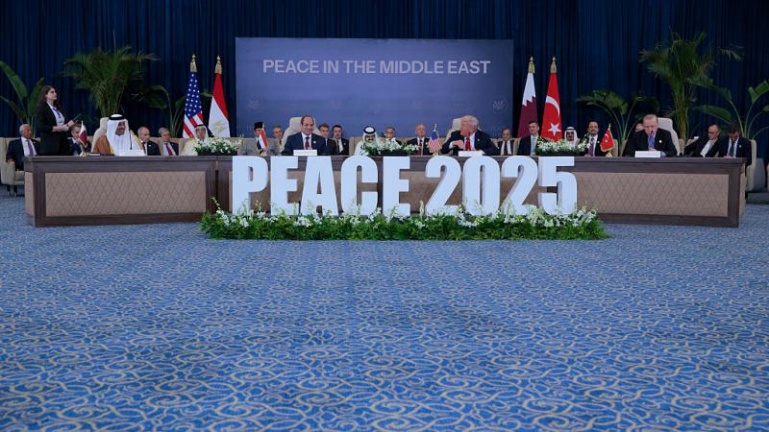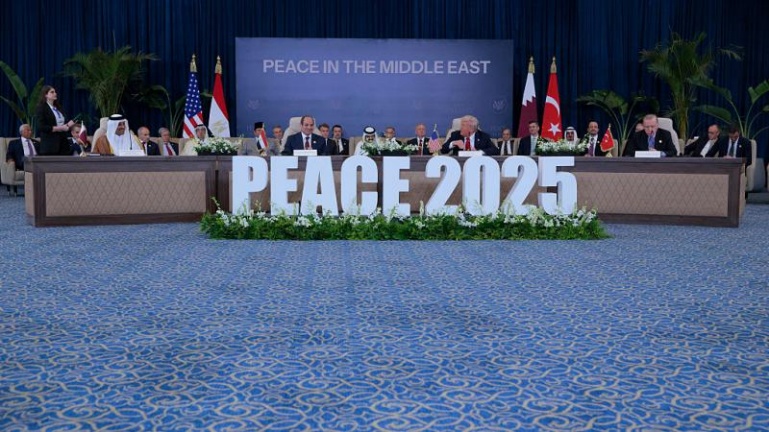 Leaders of the United States, Egypt, Turkey and Qatar sign the declaration in Sharm el-Sheikh (al-Arabi Channel, October 13, 2025)
Leaders of the United States, Egypt, Turkey and Qatar sign the declaration in Sharm el-Sheikh (al-Arabi Channel, October 13, 2025)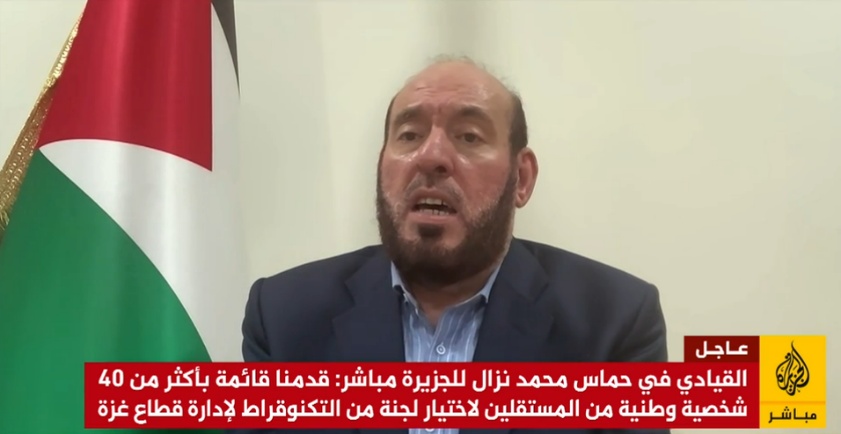 Muhammad Nazzal (Al Jazeera Mubasher, October 18, 2025)
Muhammad Nazzal (Al Jazeera Mubasher, October 18, 2025)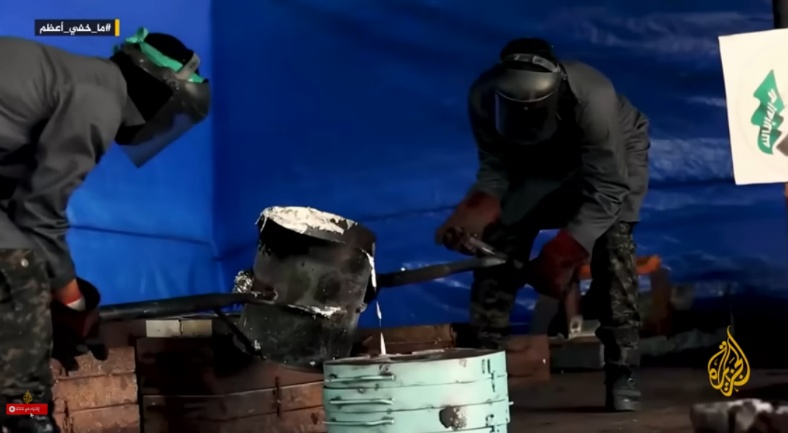 Reusing remains of IDF ordnance (Al Jazeera, September 13, 2020)
Reusing remains of IDF ordnance (Al Jazeera, September 13, 2020)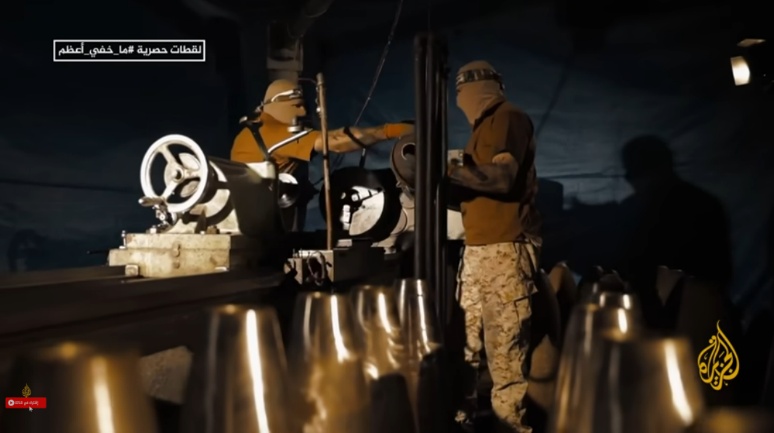 Reusing remains of IDF ordnance (Al Jazeera, September 13, 2020)
Reusing remains of IDF ordnance (Al Jazeera, September 13, 2020)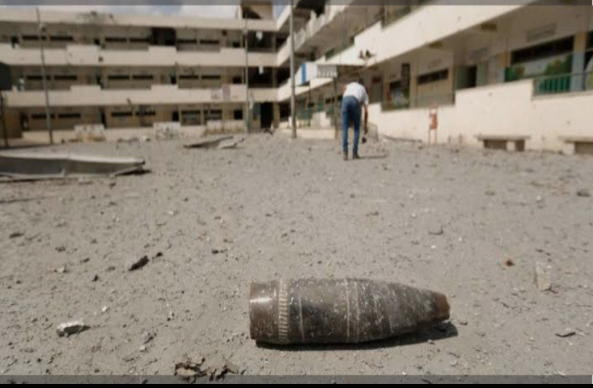 IDF ordnance displayed on a Hamas campaign poster for weapons collection (al-Risalah, October 18, 2025)
IDF ordnance displayed on a Hamas campaign poster for weapons collection (al-Risalah, October 18, 2025)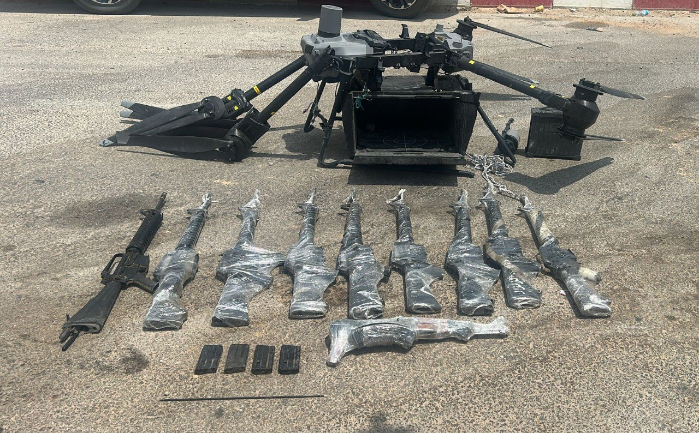 A drone captured on the Egyptian border during an attempt to smuggle weapons (IDF spokesperson, August 10, 2025) Dror Doron
A drone captured on the Egyptian border during an attempt to smuggle weapons (IDF spokesperson, August 10, 2025) Dror Doron
Overview[1]
The American Twenty-Point Plan, which served as the basis for the ceasefire agreement to end the Gaza Strip War, explicitly stipulates that during the second phase Hamas and the other armed terrorist organizations in the Gaza Strip will be required to disarm and the Strip will become a demilitarized zone.
Senior Hamas figures made it clear that although they were committed to maintaining the ceasefire, they were not willing disarm the “resistance”[2] until the establishment of a Palestinian state. They also reiterated that it was “a complex issue that had to be deliberated’ within “a broader framework of general Palestinian understandings about the future of the Strip.”
As after the previous rounds of fighting, and despite the demand that it disarm, Hamas quickly took advantage of the ceasefire to rebuild its military wing by collecting unexploded ordnance and ammunition left in the Gaza Strip after two years of war. In all probability, to restore its arsenal Hamas will use weapons smuggled across the Egyptian border via civilian drones and the entry of raw materials and dual-purpose equipment intended for the reconstruction of the Strip to manufacture weapons.
In ITIC assessment, Hamas’ unwillingness to relinquish the weapons of the “resistance” reflect its determination to continue the armed “struggle”[3] against Israel under the pretext of a “legal and religious [sic] right to fight the occupation.” Therefore, until a new, temporary administration is established in the Gaza Strip, Hamas can be expected to take advantage of the interim period to rebuild its military capabilities, with Iran also expected to continue backing Hamas by providing financial aid, supplying weapons, and transferring technical and other knowledge and training. The involvement of Qatar and Turkey, Hamas’ allies, in shaping the “day after” in Gaza can be expected to obstruct the establishment of a temporary administration which could lead genuine, sincere efforts to limit Hamas’ activity and disarm it. However, even if the temporary administration demonstrates determination, Hamas will continue to use its proven experience to adapt its military buildup processes to the changing situations on the ground.
Disarming Hamas and the Ceasefire Agreement
The American Twenty-Point Plan for the future of the Gaza Strip, presented in late September 2025, served as the basis for the ceasefire agreement between Israel and Hamas which went into effect on October 10, 2025. According to the agreement, IDF forces were redeployed in the Strip, the living Israeli hostages were released in exchange for the release of hundreds of Palestinian prisoners held in Israel, and Hamas began returning the bodies of the murdered hostages. According to the second phase of the plan, which is expected to be subject to indirect negotiations between Israel and Hamas, Hamas and the other armed organizations would have no role in governing the Gaza Strip and all military, terrorist, and offensive facilities, including tunnels and weapons production, would be destroyed and not rebuilt. The Gaza Strip would be demilitarized under the supervision of independent inspectors (White House X account, September 30, 2025).
At the peace summit held in Sharm el-Sheikh on October 13, 2025, after the ceasefire went into effect, the leaders of the United States, Egypt, Turkey and Qatar signed a joint declaration expressing commitment to implementing the American plan “in a way that would enable “peace, stability, and security” (White House website, October 13, 2025). The text of the declaration did not specifically mention disarming Hamas or demilitarizing the Gaza Strip, and thereby allowed room for interpretation regarding the operational steps required for the plan to be implemented as written. However, the American president warned Hamas that strict measures would be taken against it if it failed to comply, including the disarmament of the movement, and even threatened to allow Israel to renew the fighting (White House X account and American media, October 13–22, 2025).

Leaders of the United States, Egypt, Turkey and Qatar sign the declaration in Sharm el-Sheikh
(al-Arabi Channel, October 13, 2025)
Hamas’ position
Since the ceasefire went into effect, Hamas has emphasized its commitment to implementing the first phase. Khalil al-Hayya, head of the Hamas political bureau, who headed the movement’s negotiation team, claimed Hamas was committed to the agreement and serious in its efforts to recover all the bodies of the dead hostages (al-Qahera al-Ekhbariya, October 21, 2025). However, there were reservations regarding the second phase, which Hamas claimed required general Palestinian consensus, and linked Hamas’ willingness to disarm to the establishment of a Palestinian state:
“A senior Hamas official” said the proposed transfer of weapons “is out of the question and not on the table” (France 24, October 11, 2025).
Hamas political bureau member Hussam Badran claimed the second phase of the plan was “very complex and difficult,” and might “require longer negotiations” (al-Quds al-Arabi, October 11, 2025).
Hamas spokesman Hazem Qassem called the issue of disarmament “complex” and requiring discussion within the framework of Palestinian national consensus “without infringing on the Palestinians’ right to defend themselves” (al-Arabiya, October 14, 2025).
Hamas information figure Walid al-Kilani stated the weapons of the “resistance” were “fundamentally” linked to the establishment of a Palestinian state and as long as the “occupation” continued the “resistance”[4] would continue (al-Mashhad, October 16, 2025).
Hamas political bureau member Muhammad Nazzal said Hamas had no intention to disarm and would maintain its “security control” in the Gaza Strip until the establishment of a new temporary administration. He claimed questions “regarding disarmament” depended on “details” to be discussed later in negotiations and did not concern only Hamas (Reuters, October 17, 2025). On another occasion, he said that Hamas opposed the imposition of arrangements which would lead to disarmament without “general understanding [sic].’ He said “there is a difference between a stabilizing force to establish security, whose creation requires discussion among the factions,[5] and a force for disarming us” (Al Jazeera Mubasher, October 18, 2025).

Muhammad Nazzal (Al Jazeera Mubasher, October 18, 2025)
Hamas figure Musa Abu Marzouq said the second part of the American plan was a “national issue” and Hamas could not decide on it alone, since it required a general national consensus and the participation of all Palestinian factions. He claimed Hamas had no “preconditions,” but “Israel’s [alleged] unwillingness” to stop the war would affect any future dialogue (Sputnik in Arabic, October 21, 2025).
Palestinian Islamic Jihad (PIJ) figures expressed a similar position. Deputy secretary general Muhammad al-Hindi said that the factions “had not agreed to disarm” and were not prepared to accept a threat to disarm them by force (Al Jazeera, October 14, 2025).
Hamas Rebuilds Its Military Wing
After previous rounds of fighting, Hamas reconstructed its military wing to prepare for a future confrontation by replenishing its weapons stockpiles, restoring infrastructure and facilities, and recruiting and training operatives. Hamas employed considerable flexibility as the military wing successfully advanced its goals despite the restrictions and difficulties it had to deal with because of Israel’s policy of prevention and disruption, and at times also because of Egypt:[6]
Iranian assistance: critical to Hamas’ military capabilities is the close relationship between the movement and the regime in Iran, which has been Hamas’ main strategic backer almost continuously since 2014. Iran’s support includes military aid (means and training) and gifts of hundreds of millions of dollars to the movement’s leadership and its military wing, including ahead of the October 7, 2023 attack and massacre. While Hamas relied on Iranian assistance to continue its “struggle” against Israel and consolidate its position in the Gaza Strip, Iran assigned Hamas a central role within the “proxy” concept underlying its regional policy promoted by the Islamic Revolutionary Guard Corps.[7]
Smuggling from the Sinai Peninsula: the Gaza-Sinai border, along with the limited control of Egyptian security forces, made the Sinai Peninsula a key logistical area for Hamas. Smuggling from Sinai through the tunnel network constructed under the border near Rafah contributed to Hamas’ military buildup in the early 2000s, especially since its takeover of the Gaza Strip in 2007. Between 2007 and 2013, enormous quantities of standard weapons were smuggled into the Strip, arriving from Iran via Sudan or from military depots in Libya and Sudan following the chaos caused by the Arab Spring. However, Hamas’ actual ability to transfer weapons from Sinai into the Strip declined dramatically over the years following attacks attributed to Israel against Iranian weapons convoys in Sudan and due to changes in Egypt’s enforcement policy, which was tightened, especially after President Abdel Fattah el-Sisi came to power in 2013 (al-Youm al-Sabea, October 30, 2014; Al Jazeera, September 18, 2015).
Independent local manufacture: for years Hamas pushed for developing local production capabilities, for example the development of the first Qassam rockets in the early 2000s. With tighter Egyptian border enforcement, the focus of Hamas’ military buildup shifted from smuggling weapons to establishing independent local military manufacturing capabilities, usually based on technical knowledge from Iran. Hamas used raw and dual-purpose materials (civilian and military) brought into the Strip through official crossings. Metalworking machinery, cement and construction materials, chemicals, and electronic components were used for extensive weapons production.[8] In a propaganda program broadcast by Al Jazeera, Hamas operatives revealed their independent production strategy and demonstrated how they extracted explosive material from the remnants of shells and bombs found in the Strip or converted water pipes into rockets (Al Jazeera, September 13, 2020). During the Gaza Strip War the IDF uncovered Hamas production sites, such as a compound operating above and below ground in the al-Bureij refugee camp which had metalworking machines, chemistry labs, and assembly and storage sites for the production of various types of rockets (Al Jazeera, September 13, 2020).


Reusing remains of IDF ordnance (Al Jazeera, September 13, 2020)
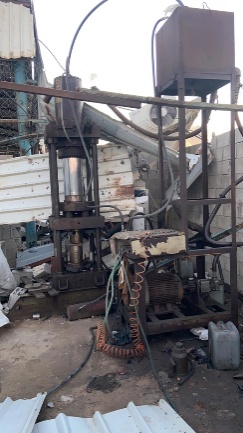

Equipment for producing Hamas weapons discovered in IDF raids in the Gaza Strip
(IDF spokesperson, January 4 and 20, 2024)
In IDF assessment, Hamas lost over 20,000 terrorist operatives during the war but as of October 2025 it still has between 10,000 and 20,000 armed operatives, many of whom were recruited during the war and received limited training. More than 280 commanders at the company and above level were eliminated, including most brigade and battalion commanders, while their replacements have less knowledge and experience than their predecessors. Hamas still possesses hundreds of rockets, some of medium range capable of reaching central Israel, and still retains more than half of the tunnels it had at the beginning of the war (Israeli media, October 22, 2025).
Immediately after the ceasefire went into effect, the first signs of Hamas’ intention to restore its military capabilities despite the demand that it disarm, became evident. On the pretext of “maintaining public safety” after two years of war, Hamas security forces launched an operation to collect weapons, ammunition, explosives, rockets and other equipment lost during the war, including thousands of IDF ordnance remnants that could be used to manufacture explosives and weapons. A call was also issued for anyone possessing ammunition or other military equipment to hand it over to security points or “resistance” operatives to “maintain security and prevent vandalism” (al-Risalah, October 18, 2025).

IDF ordnance displayed on a Hamas campaign poster for weapons collection
(al-Risalah, October 18, 2025)
In addition, the process of reconstructing the Gaza Strip will require bringing in massive quantities of construction equipment and dual-purpose raw materials such as concrete, cement, metal, metalworking machines and various chemicals for reconstructing the agricultural and civilian industrial sectors. As in the past, if Hamas takes control of or gains access to the materials, they will use them for a wide range of military purposes.
Hamas may also focus on smuggling critical military equipment from the Sinai Peninsula into the Gaza Strip, particularly electronic components, despite the presence of IDF forces along the Philadelphi Axis and the deployment of Egyptian security forces. To that end it can be expected to rebuild the smuggling tunnels under the border, use fishing boats for maritime smuggling or exploit the airspace, which in recent years has become an important route criminal networks use to smuggle weapons and drugs with civilian drones capable of carrying loads of tens of kilograms and even serving as attack weapons. Since July 2025, the IDF foiled eight attempts to use drones to smuggle weapons and drugs from the Egyptian border (IDF spokesperson, July 1–October 22, 2025). However, according to data presented in the Knesset,[9] in the three months leading up to October 2025, there were nearly 900 incidents of drones used in smuggling from Egypt into Israel (Ynet, October 15, 2025). It was also reported that after being smuggled in from Egypt, some of the weapons were transferred to the Kerem Shalom area and from there transferred to the Gaza Strip via drones (Maariv, October 22, 2025).

A drone captured on the Egyptian border during an attempt to smuggle weapons
(IDF spokesperson, August 10, 2025)
Hamas’ ability to reestablish its independent military production also depends on the nature of the Gaza Strip’s future governance and its ability to confront Hamas. The fact that Qatar and Turkey, which are Hamas allies and provide refuge for the movement’s leadership abroad, serve as guarantors of the ceasefire agreement is liable to complicate efforts to limit the movement’s activity and disarm it. In the joint statement by the Emir of Qatar and the President of Turkey following a meeting of their Supreme Strategic Committee, in which they referred to the need to fulfill the ceasefire agreement’s commitments, ensure the entry of humanitarian aid, and create the best conditions for the return of the displaced persons and reconstruction, no mention was made of disarmament or the demilitarization of the Gaza Strip (Qatari News Agency, October 22, 2025). Moreover, the presence in the Gaza Strip of organizations such as the Turkish IHH, which is close to Hamas, can provide Hamas with a direct channel for transferring funds and equipment to aid in rehabilitating its military wing disguised as humanitarian aid.[10]
Iran, which continues to express its support for Hamas, is also expected to play a significant role in driving Hamas’ renewed military buildup through the transfer of weapons, funds, information, production technology and the training of operatives on its territory.
[1] Click https://www.terrorism-info.org.il/en to subscribe and receive the ITIC’s daily updates as well as its other publications.
[2] i.e., the terrorist organizations operating in the Gaza Strip.
[3] Terrorist attacks.
[4] Anti-Israeli violence and terrorism.
[5] Terrorist organizations.
[6] For further information, see the June 2008 ITIC report, The Gaza Strip after Operation Cast Lead: The rebuilding of the civilian and military infrastructure in the Gaza Strip carried out by Hamas. At the same time, Hamas continues entrenching its control of the Gaza Strip.; the March 2011 report, Terrorism from the Gaza Strip since Operation Cast Lead:Data, Type and Trends; and the June 2015 report, The Gaza Strip One Year after Operation Protective Edge: An Overview.
[7] For further information, see the November 2024 ITIC report, Captured Documents Show Iranian Support for Hamas in the Gaza Strip
[8] For further information, see the August 2014 ITIC report, After Operation Cast Lead Hamas Used Cement Delivered to the Gaza Strip to Rebuild and Upgrade Its Military-Terrorist Infrastructure at the Expense of Civilian Needs.
[9] The Israeli parliament.
[10] For further information, see the October 2025 ITIC report, The Turkish IHH, which led the Mavi Marmara flotilla, operates in the Gaza Strip and is involved in its reconstruction.
Related Articles

